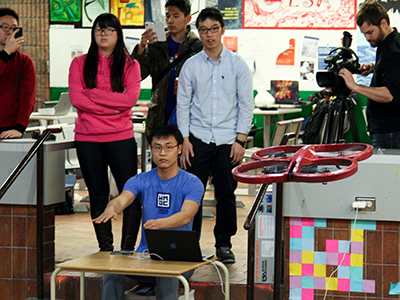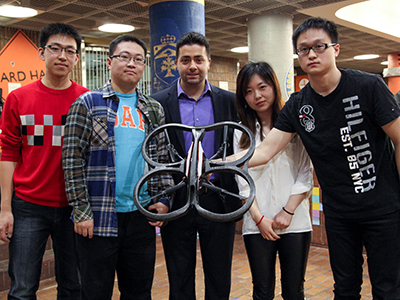
March 20, 2014
With the flick of a wrist, Silverio Miranda (CompE 1T4) sends a drone soaring high in the air, flipping and rotating with ease. But he’s not using The Force—he’s flying a gesture-controlled quadcopter piloted entirely by his hand and arm movements.
A long time ago, in a galaxy far, far away—well, actually, Wednesday night in the Sandford Fleming atrium—speed and stunts worthy of the Millenium Falcon wowed the crowd at the first Jedi Wars flying robotics competition. Fourth-year undergraduate students in The Edward S. Rogers Sr. Department of Electrical & Computer Engineering (ECE) put their gesture-controlled drones to the test in a battle that displayed their skills in programming, piloting, teamwork and creativity.
The four teams—Team AFK, Team Freedom, Team Goose and Team Roar—have spent the past year designing and writing unique gesture-input programs to control the drones, and practicing precision piloting. Energy was high ahead of the first event, the talent competition, designed to show off original stunts and manoeuvres. “I’m a little nervous,” said Xiabo Zhang (CompE 1T4), pilot for Team Goose. “We have a secret weapon we’re going to bring out, we’ll see if it works.”
Professor Parham Aarabi acted as faculty advisor to all four teams, helping them hone their skills over the course of the year. “They’ve come up with a lot of interesting aerial tricks and new manoeuvers we haven’t seen before,” said Professor Aarabi. “My prediction of who would win this competition has changed continuously throughout the year.”
Team AFK took top prize in the talent competition, stunning the audience by performing precision spins and flips about 10 metres off the ground, at eye level for viewers watching from the second floor. This earned them a five-second headstart during the time trial race, after which teams were ranked from first to fourth before proceeding straight into semi-finals, then the bronze and gold-medal matches.

Speed and efficient flying won Team Roar the gold medal. Each member of Team Roar took home a Leap Motion Controller, a device that lets you interact with your computer, robots and smart devices by moving your hands and fingers in the air—translating your motions into precise 3D input. Silver-medal winners Team AFK also earned prizes from Leap Motion, and Team Freedom won the glory of bronze.
“I think we deserved this win because it’s been a long process, a lot of late nights,” said Team Roar’s Junqian Zhang (ElecE 1T4). “We focused on developing good tricks for the talent portion, but that was really time-consuming,” added Ming Fei Wang (CompE 1T4). “We crashed a lot of times.”
Professor Aarabi has hosted robotics competitions before, but never with flying robots. “This was about students using their own imaginations to see what they can do with some really cool technology,” said Professor Aarabi. “It was great to see so many people enthusiastic about the projects, and to see the students having fun.”
Want to learn how the students wrote gesture-control programs? This video from the event explains all!
Watch a segment about Jedi Wars on the Space Channel television show InnerSpace—cameras were on hand to interview all four teams and film the fierce competition.
See more photos from Jedi Wars 2014.
More information:
Marit Mitchell
Senior Communications Officer
The Edward S. Rogers Sr. Department of Electrical & Computer Engineering
416-978-7997; marit.mitchell@utoronto.ca